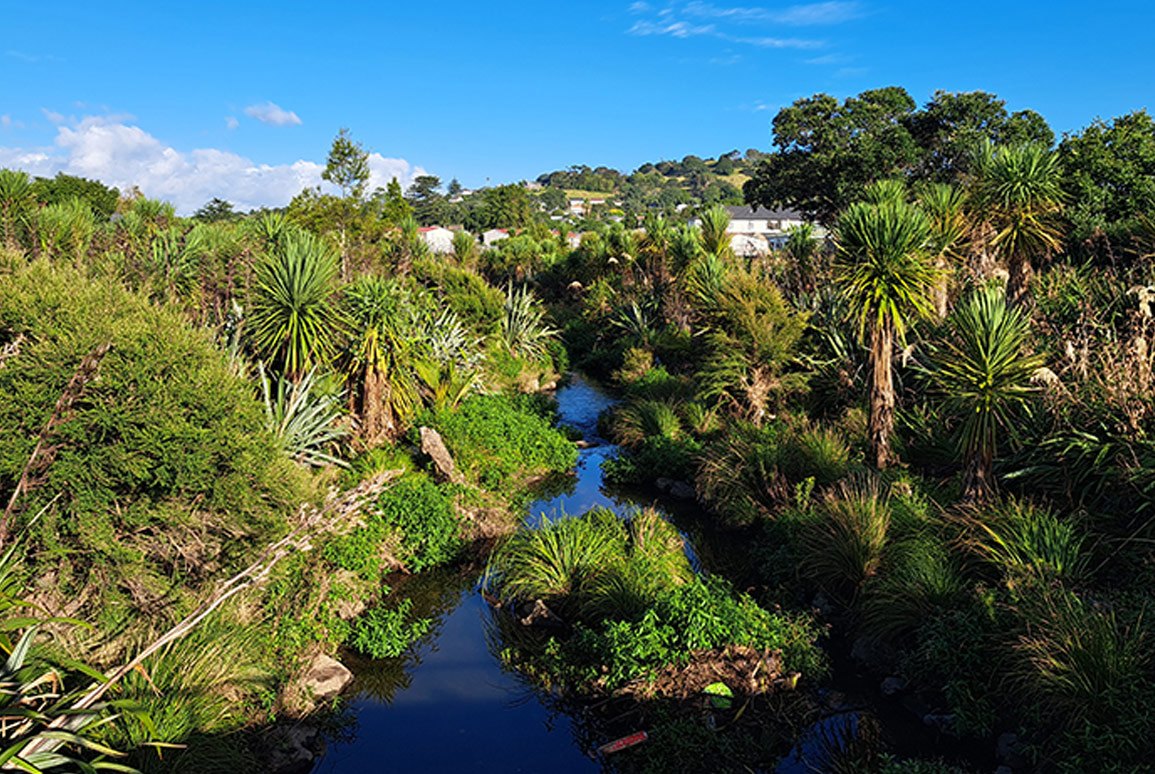Green infrastructure implementation in Auckland and beyond
27 February 2023
Auckland can be proud of efforts towards investing in green infrastructure, says landscape architect Mark Lewis; and Resource Management reform should seek to support further implementation of blue-green networks.

Auckland’s parks and greenways were a saving grace in Auckland’s recent floods. Our urban stormwater systems are only designed to accommodate discreet targeted rainfall events, with an ‘acceptable’ loss of service to our roads and infrastructure for larger events. Unfortunately, we have seen the damage that can occur when our infrastructure is overwhelmed, and it has reinforced the importance to provide our rivers and wetlands ‘the room’ they need to accommodate current and future climatic extremes and provide an additional level of resilience to our built environments.
The Auckland region has lost an estimated 95% of its natural wetland environments, and in doing so, we have lost the functional value of these natural systems to capture, slow, and infiltrate rainwater to our aquifers. Wetlands also replenish groundwater and stream flows, thereby moderating the region’s arid (drought) conditions, and the associated erosion and fire risk.
Thankfully, there is an increasing number of projects in Auckland seeking to reintegrate natural systems into our urban environments, and these have fared well in the recent Auckland storms, with favourable reporting on Hobsonville’s greenways, the restored awa Te Ara Raata, and the recent daylighted section of Te Ara Awataha in Northcote.
Te Auaunga through Underwood and Walmsley reserves also held up well. This green infrastructure project rehabilitated 2km of channelised stream, daylighted seven additional tributaries, and restored eight hectares of wetlands and floodplain environments. Unfortunately, there were some low-lying homes impacted by the extreme nature of the recent event, but it appears flooding was broadly reduced for most residences normally affected. Furthermore, it is worth noting that Te Auaunga project was not intended as a panacea for flooding — it sought to restore a part of the ancestral wetland Wai-o-Rakataura, but it did not replicate its size or natural capacity. The logical next phase is to continue the ecological restoration upstream on Te Auaunga, and ‘sideways’ into the Mt Roskill catchment, where large-scale housing intensification provides opportunities for green infrastructure to be woven into future development form.
Restoration of river and wetland systems is an example of a nature-based solution (NbS). NbS have a critical role in supporting New Zealand by simultaneously adapting to and mitigating the most severe impacts of climate change. NbS can mitigate many of the priority risks identified within the National Climate Change Risk Assessment, through their inherent collaboration and engagement, by sustainably managing our natural capital and biodiversity, and by enhancing the resilience of New Zealand’s economy through benefits for both nature and people.
A recent New Zealand survey of nature-based solutions found that there was already significant community support for green infrastructure and that the technical challenges were not overwhelming (Alestra et al 2023). The findings of this study and international case studies (Kazmierczak & Carter, 2010) found the following immediate requirements to move forward with the broader implementation of NbS:
- Collaboration between government, professionals, iwi, and communities.
- Consistency across national, regional and local policy, and between water, land and community resource planning.
- Ongoing monitoring, evaluation, and sharing of project data to provide for wider acceptance and technical understanding of NbS.
- The development of novel financial mechanisms and investment opportunities.
New Zealand’s resource management reform has the potential to enable NbS like wetland and stream rehabilitation. The proposed Regional Spatial Strategies provide an opportunity to give strategic direction to future land use and infrastructure decisions, including blue-green networks. These strategies will be reliant on the National Planning Framework, which has the potential to guide the minimum requirements for blue-green infrastructure (ideally above and beyond reductionist targets) towards something more akin to Te Mana o Te Awa — a ‘best for river’ and collaborative approach to infrastructure planning. The planning framework is also a means to drive consistency between divergent policies.
Finally, the Natural and Built Environment Plans can provide specific policy and regulatory controls to support and direct NbS, and to ultimately realise their true potential in supporting our future resilient communities.
Find out more
Te Auaunga wins Institute of Public Works Engineering Australasia Award
For further information please contact Mark Lewis

